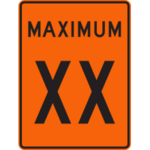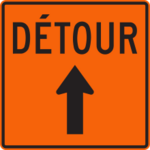Traffic Signs and Signals
Signage in a roadwork zone
When roadworks are involved, you need to pay specific attention to work signs. In this way, you can make sure you and the workers are safe.
There are several ways of informing you of construction, maintenance or rehabilitation work being carried out on or near public roads. Various strategies are also in place to make sure that users can get around safely.
Orange traffic signs
Orange road signs inform you of the presence of roadworks. In particular, they can indicate:
- the distance to be covered before reaching a work area
- the presence of a flagman or flagwoman directing traffic;
- a change in speed limit from that normally identified;
- an area temporarily closed to traffic.
Temporary speed limits
A temporary speed limit may be necessary, given the configuration of the work zone and the presence of workers. In a roadwork zone, police surveillance is often reinforced. If you exceed the speed limit, you risk receiving a double fine.
The maximum speed at which you are allowed to travel is indicated on an orange sign like this one.

Presence of signallers
The following sign indicates the presence of a flagman or flagwoman to direct traffic. Note that this sign is the only one with flags to attract drivers’ attention.

It means that traffic must be slowed, diverted or stopped temporarily because there are workers and work vehicles on the road. You must then follow the orders of the road signaller. It is important to show caution and respect for the flagmen and flagwomen.
Merging lanes
This sign is installed at the edge of a public road when two lanes of traffic in the same direction are merged into one.
The sign below indicates that the left-hand lane is temporarily closed and that you must change lanes if you find yourself in it. You must therefore use the other lanes open to traffic.

Mobile photo radar
The following sign indicates that a nearby work zone is identified for mobile photo radar surveillance and that a device may be present. When present, it measures the speed of vehicles and takes photos of those exceeding the speed limit.

Diagonal arrow
This sign indicates the direction to follow in the vicinity of the construction site. The diagonal arrow is installed at the beginning of the taper that completely closes off a traffic lane. The sign can also be used when a lane is narrowed.

Truck crossing
This sign indicates that a loaded truck can access the public road by leaving the access lane.

Road blocked
The following sign indicates that the road is closed to traffic. You must then follow the detour signs.

Detour
These signs indicate the direction of the planned detour route that you must follow because of the work.

Presence of road signallers
A traffic signaller directs the movement of road users in roadwork zones. You can recognize them by their yellow-green fluorescent helmets and clothing. In their presence, you must obey the following signs.
Order to stop
To ask you to stop your vehicle, the flagman or flagwoman raises his or her hand and uses an octagonal-shaped sign bearing the words “Arrêt” or “Stop”.

To ask you to stop, the flagman or flagwoman can also hold up an orange flag with a yellow x and raise his or her hand.

Order to slow down
To ask you to slow down, the signaller turns his or her octagonal-shaped sign to show an orange background bearing the words “Lentement” (“Slowly”).

Order to move
To ask you to move along, the flagman or flagwoman waves to you, as shown in the image below. At this point, his or her sign or flag is placed to one side to avoid confusion.


Vehicle with rotating beacon
A yellow beacon on a vehicle indicates to road users that the vehicle may:
- impede traffic flow;
- be travelling well below the speed limit;
- be accompanying another vehicle whose maneuvers may be impeding traffic.
In the presence of such a vehicle, you must exercise special caution.
Signal light arrow
The illuminated warning arrow indicates the presence of a work area and points you in the right direction when a lane is obstructed or closed. It is mounted on a vehicle or trailer.
Traffic control gate
A gate can be used to stop and move road users. It is remotely controlled by a traffic signaller located outside the traffic lanes.
When the red light is activated, the barrier is lowered, exposing the flag to indicate that you should stop. When the yellow light is activated, the barrier is raised. You must then drive slowly.

Gate ordering to stop

Gate giving the order to drive slowly
Reducing the impact of construction work on traffic
Reducing the impact of roadworks on traffic remains a major challenge. Various strategies are being put in place to facilitate the mobility of road users during the construction period. These include:
- work is carried out mainly in the evening, at night and on weekends, when traffic levels are lower on the road network;
- construction of detour roads;
- the use of shoulders to maintain the number of traffic lanes;
- construction of temporary overpasses to make maintain traffic on roads;
- the use of movable guardrails to modify the number of traffic lanes more quickly, depending on traffic volumes;
- the use of variable message signs to inform users of road obstructions and detour roads;
- specific measures to maintain pedestrian and cycling links;
- continuous broadcasting of information on road obstructions on Québec 511;
- improved public transit services, in collaboration with public transit companies.
Last update: May 9, 2024





